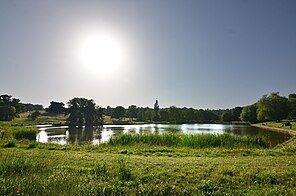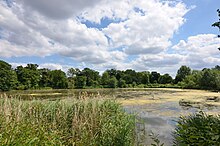Hampstead Heath Ponds
| Hampstead Heath Ponds | |
|---|---|
 Hampstead Heath's Model Boating Pond
(Highgate Pond #3). | |
| Location | London, England |
| Coordinates | 51°33′51″N 0°9′24″W / 51.56417°N 0.15667°W |
| Type | Artificial lake/Reservoir, created 1777 |
| Primary inflows | River Fleet |
| Primary outflows | Storm Relief Sewer |
| Basin countries | England |
| Surface area | 17.3 ha (43 acres) |
| Max. depth | Varies by pond |
| Water volume | Varies by pond |
| Islands | 2 (within the 11 main ponds) |
Hampstead Heath has some thirty ponds on or adjacent to it. The main Hampstead Heath Ponds were originally dug in the 17th and 18th centuries as reservoirs to meet London's growing water demand. These main ponds are divided in to two groups: the three Hampstead Ponds (West Heath Side) and the eight Highgate Ponds (East Heath Side). Both sets of ponds are officially numbered incrementally from South to North, the southernmost pond being Hampstead #1 pond and the northernmost being Highgate #8 (Kenwood House’s Wood Pond).
The majority of the ponds on Hampstead Heath are fed by the headwater springs of the River Fleet. Three of the main ponds are now large freshwater bathing/swimming ponds: two designated single sex (male/female Highgate #2 & Highgate #5 respectively); and one for mixed bathing (Hampstead #3). The bathing ponds aren’t the only special-use ponds however, Highgate #3 pond is the Model Boating Pond and it, along with a few other ponds, are open to anglers. A number of the other ponds are set-aside as wildlife reserves or are purely ornamental (such as the more minor Viaduct Pond).
In 2004, the City of London Corporation, which holds the Heath in trust since the abolition of the Greater London Council in 1986, tried to close the bathing ponds on the grounds that they were an unsustainable drain on their expenses and posed a health risk to swimmers. The swimmers challenged this and won a victory in the High Court. To defray costs, the Corporation introduced a charge for admission of £2 per session, £1 for concessions. There was some opposition to this on the grounds that swimming there had been free since at least the 1920s, and some ticket machines were vandalised.
Hampstead ponds

The Hampstead Ponds consist of three ponds on the heath's south-west corner, towards South End Green. Hampstead Pond #3 is the mixed bathing pond, where both sexes may swim (angling prohibited).
Hampstead ponds #1 is strictly a nature/wildlife pond and Hampstead pond #2 permits angling.
Directly north-west of the mixed bathing pong is the "Viaduct Pond" and west of that is the Vale of Health pond, these are arguably within the flow of the "Hampstead ponds", but aren't officially members of the group.
Highgate ponds

Highgate Ponds are a series of eight former reservoirs, on the heath's east (Highgate) side, and were originally dug in the 17th and 18th centuries.[1] They include two single-sex swimming pools (the men's and ladies' bathing ponds), a model boating pond, and two ponds which serve as wildlife reserves: the Stock Pond and the Bird Sanctuary Pond. Angling is allowed in some of the ponds, although this may be threatened by proposals to modify the dams. The ponds are the result of the 1777 damming of Hampstead Brook (one of the Fleet River's sources), by the Hampstead Water Company, which was formed in 1692 to meet London's growing water demands.[2]
"Boudicca's Mound", near the present men's bathing pond, is a tumulus where, according to local legend, Queen Boudicca (Boadicea) was buried after she and 10,000 Iceni warriors were defeated at Battle Bridge.[3] However, historical drawings and paintings of the area show no mound other than a 17th-century windmill.
Swimming ponds

Hampstead has three different ponds for swimming: one for men, one for women and one mixed. Only swimmers over eight years of age are allowed; those between eight and 15 years old must be in the care of an adult. Winter swimming is sometimes available at the ponds, which remain popular with users.
The men's pond had a diving tower, but this was dismantled following an accident in the 1970s and only a low level board remains, along with showers and a small sunbathing and changing area.
Quality of water tests — which comply with EU regulations — are routinely performed on all three swimming ponds, and results are available through the official City of London website. The three ponds are not to be confused with Parliament Hill Lido, built in 1938, now with a stainless steel lining.
Proposals for the ponds and dams
In 2011, it was announced that the City of London was proposing extensive works on the ponds and dams, which it claimed were necessary for safety reasons in the event of a rare major storm. The proposals included measures to improve the water quality of the ponds as well as improvements to the pipes and weirs that allow water to cascade from one pond to the other. These initial recommendations followed engineers' reports in 2005 that the hydrology of the ponds was poorly understood. These same engineering reports resulted in engineering works in 2006 on the two ponds in the grounds of Kenwood House, to make their overflow structures and dams safer. Since 2011 there has been strong opposition from the swimming clubs and the Protect Our Ponds campaign. In 2013 a united campaign was launched called Dam Nonsense to oppose the works, which the campaign claimed unnecessary and in conflict with the Hampstead Heath Act 1871. The campaign includes all the groups opposed to the proposals. The proposed work on the Hampstead Heath dams is further complicated by the regulations embodied in the 1975 Reservoir Act, which only relate to three dams on the Heath, and the proposed regulations under the Flood and Water Management Act 2010 which potentially relate to all 14 dams on the Heath. The Heath and Hampstead Society took the engineering decisions of the City of London to judicial review in November 2014: the interpretation of the 1975 Reservoir Act was challenged and thereby the nature of the proposed engineering works to the dams. The case was heard by The Honourable Mrs Justice Lang (DBE) and a ruling, in favour of the City of London, was issued on 28 November 2014 (case number CO/4175/2014). The judgement also addressed the status of the proposed engineering works relative to the provisions of the 1871 Act, again ruling that the engineers had shown due consideration for the provisions of the Act. Following the judicial review, the City of London now awaits the decision on the planning application for the engineering works, which is being opposed by The Heath and Hampstead Society and the Dam Nonsense campaign.
If the work goes ahead it is likely to involve the closure of all three swimming ponds for a prolonged period of time to enable higher dams to be built which will raise their heights, in the case of the dam above the Men's Swimming Pond by 18 feet. The City of London Corporation has said the work should be carried out urgently to reduce danger of flooding in surrounding built-up residential areas in the event of one of the dams bursting. The initial estimate of the number of lives which might be lost, in the event of a dam collapse in an extreme flood event, was over 2000 [4] (2006 estimate). This figure has been reduced to less than 400,[4] still a large number. However the chance of such an event is one in 400,000 years.[5] At a public meeting to launch the Dam Nonsense Campaign held on 25 November 2013, more than 200 people voted in favour of the campaign with only one vote against.[6]
The regulated dams under the 1975 Reservoir Act are the Model Pond and the Men's Bathing Pond in the Highgate Chain. Highgate Number 1 pond would have been covered by the Act but the water level was lowered by the GLC in 1984. In the Hampstead chain, Hampstead Number 1 pond is also regulated under the 1975 Act.
Location
The men and women's ponds are on the eastern side of the park, off of Millfield Lane. The mixed bathing pond is in the centre of the Heath, and is a 10-15 minute walk from Hampstead Heath railway station and from South End Green, at the junction of Pond Street and East Heath Road, which is served by several bus routes.
Controversies
Controversy broke out in December of 2017 after the City of London corporation, in charge of running the pools, confirmed that transgender women are allowed to use the women's pool per the Equality Act 2010. Julie Bindel, who uses the pond regularly, criticised the decision to be welcoming towards trans women, although reaction was more positive from other groups.[7][8]
References
- ^ CIX.co.UK: Hampstead Heath Ponds Archived 4 January 2009 at the Wayback Machine
- ^ "Hampstead: Hampstead Heath - British History Online". www.british-history.ac.uk. Retrieved 30 March 2018.
- ^ [1] London, Rob Humphreys, Rough Guides Ltd, 2004, ISBN 978-1-84353-316-0
- ^ a b "soul - Definition of soul in English by Oxford Dictionaries". Oxford Dictionaries - English.
- ^ Ponds and dams, City of London Corporation.
- ^ Protect Our Ponds documents the debate since 2011 until the present time[when?] regarding the proposed works to the dams on the Heath ponds, including the three swimming ponds.
- ^ https://www.theguardian.com/world/2018/feb/09/debate-over-inclusion-of-trans-women-in-women-only-spaces-intensifies
- ^ https://www.independent.co.uk/life-style/transgender-women-hampstead-heath-ladies-pond-kenwood-kate-moss-a8136581.html
External links
- [2] Highgate Men's Pond Association (HMPA) is an organisation of swimmers set up in 2012. It has a chair, secretary and treasurer plus a committee of 12, all democratically elected. It currently (Dec 2013) has 550 supporters on email list, many of whom pay an annual subscription.
- Protect Our Ponds
- The London Encyclopaedia, Ben Weinreb and Christopher Hibbert, Macmillan.
- City of London Corporation, Swimming on Hampstead Heath, also gives water temperatures.
- Diving at Highgate Ponds on the Lost Lidos website.
